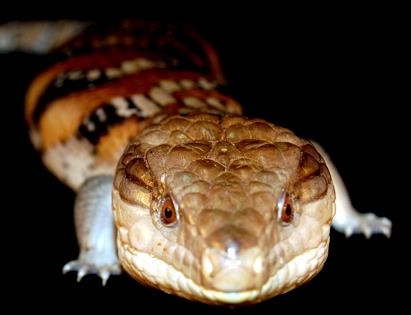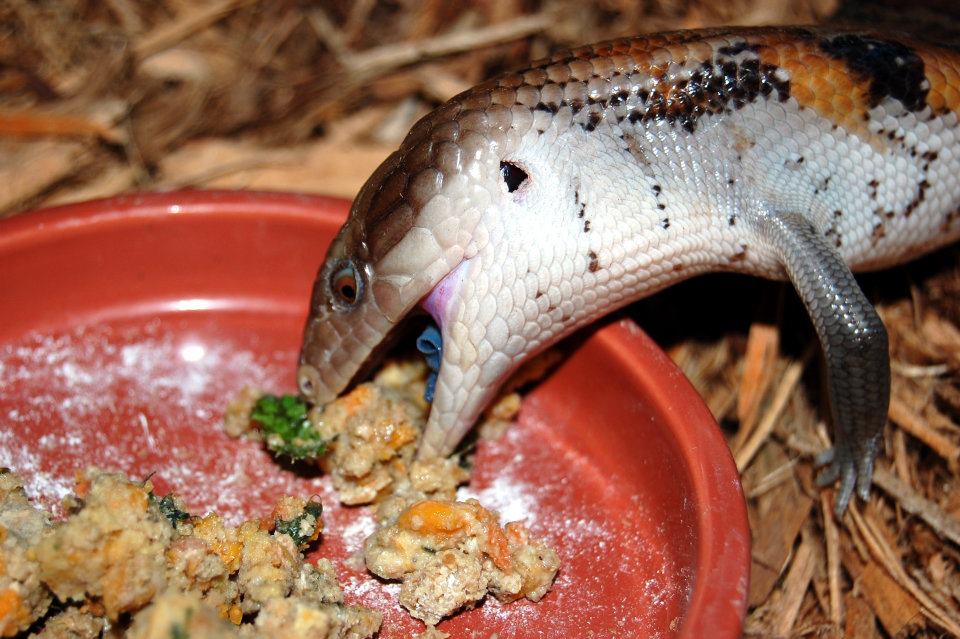Basic Care: Blue-Tongue Skinks
 Blue-tongues are by far the most popular pet skink which can be hardy captives if they are captive-bred. Many captive-bred pet blue-tongue skinks will become quite friendly and beg to come out when they spot their main care-giver. Captive-bred blue-tongue skinks can be much easier to raise than bearded dragons. Blue-tongue skinks are more tolerant of lower temperatures and have lower ultraviolet-B requirements. They do not require live food and do well on a diet of green leafy produce mixed with fruits, legumes and other vegetables, and an animal protein source. Blue-tongue skinks are very tolerant of handling and become quite tractable as they get larger and eventually become “lap lizards” with regular gentle handling. Blue-tongue skinks are much longer-lived than bearded dragons, often reaching their teens and twenties.
Blue-tongues are by far the most popular pet skink which can be hardy captives if they are captive-bred. Many captive-bred pet blue-tongue skinks will become quite friendly and beg to come out when they spot their main care-giver. Captive-bred blue-tongue skinks can be much easier to raise than bearded dragons. Blue-tongue skinks are more tolerant of lower temperatures and have lower ultraviolet-B requirements. They do not require live food and do well on a diet of green leafy produce mixed with fruits, legumes and other vegetables, and an animal protein source. Blue-tongue skinks are very tolerant of handling and become quite tractable as they get larger and eventually become “lap lizards” with regular gentle handling. Blue-tongue skinks are much longer-lived than bearded dragons, often reaching their teens and twenties.
Wild-collected specimens may be fussy in their diet and not particularly pleasant in disposition. Wild-caught skinks maintain a defensive attitude for years, hissing, wriggling, voiding their cloacas, and even biting when handled, and are NOT good pets. Wild-caught specimens of New Guinea blue-tongues (Tiliqua gigas) and Irian Jaya blue-tongues (Tiliqua sp.) are still imported of both.
As stated above, captive-bred blue-tongues are care better pets and hardier captives. The Irian Jaya is regularly available as captive-bred specimens while the New Guinea is only occasionally available. Two subspecies of Australian blue-tongue skinks are commonly available as captive-bred specimens, the northern and eastern (T. scincoides scincoides and T. scincoides intermedia). However, many of the Australian origin blue-tongues in the United States appear to be interspecific hybrids. Some color morphs have been selectively bred such as sunglow, flame, and high orange. Other bluetongue subspecies that are occasionally bred are Tanimbar Island (Tiliqua scincoides chimera) and Kei Island (Tiliqua gigas keyensis).
The remaining Australian species are coveted for their odd appearance or beautiful patterns and may fetch high prices despite being common in the wild. The few captive specimens outside of Australia of Central, blotched, and Western blue-tongues and shingleback skinks are likely the result of smuggled specimens (or breedings of smuggled animals) as no legal exports for the pet trade have occurred in decades. The pygmy bluetongue is actually an endangered species and is legally protected.
An excellent pictorial guide to the different blue-tongue skink species is available at www.bluetongueskinks.net.
Sex Determination:
Blue-tongues may be sexed by contrast radiography or endoscopy. A guess to an adult’s gender can often be made by observing their size and shape of their heads, with the heads of males tending to be larger and wider than that of females.
Captive Care Requirements:
Enclosure
A minimum sized cage is 36 to 48 inches long, 18 to 24 inches deep, and 18 to 24 inches high. The cage should be well ventilated. Some keepers who raise and breed them house them in sweater box racks designed for small boas and pythons while others prefer a more spacious and visible enclosure.
Blue-tongue skinks are not very tolerant of other skinks except during mating season so must housed one to an enclosure to prevent fighting.
Substrate
Recommendations include cypress mulch (great for dry climates especially mixed with damp sphagnum moss), aspen shavings, newspaper, or cage carpet.
Cage Furnishings
They will climb rocks and thick branches but do well in cages without a lot of height. A humid hide box filled with damp sphagnum should be provided to help with skin shedding.
A water bowl should be available that is in a sturdy difficult to tip crock. The crock should be large enough for it to soak its whole body to help with shedding.
Lighting
UVB lighting should be provided for optimum health, particularly for neonates and juveniles. Click here for more information on UVB lighting. A 12-hour photoperiod works well.
Heating
A hot spot of 85 to 95°F at one end of the cage is sufficient and may be provided by a combination of an under-tank heat element and a basking spotlight. Click here for more information on heating and temperature control for reptiles.
Diet
 Blue-tongue skinks are omnivores. Their diet should consist of 50% fresh vegetables, 40% protein, and 10% fresh fruit. Feed green leafy produce, legumes and other vegetables, an animal protein source, and a small amount of fruit enhancement to their salads. Repashy Superfoods also offers gel based diets, such as Bluey Buffet, that can easily be incorporated into their diets.
Blue-tongue skinks are omnivores. Their diet should consist of 50% fresh vegetables, 40% protein, and 10% fresh fruit. Feed green leafy produce, legumes and other vegetables, an animal protein source, and a small amount of fruit enhancement to their salads. Repashy Superfoods also offers gel based diets, such as Bluey Buffet, that can easily be incorporated into their diets.
Neonatal skinks and young skinks should be fed daily as much as they will eat. Adult skinks do well on one to two feedings a week. Blue-tongue skinks have to have their food intake monitored or else they readily become obese.
Protein source options include: Harrison’s Bird Diets High Potency Coarse Pellets, ZuPreem's Monkey Biscuits, semi-moist super premium dog or cat food (i.e. turkey, venison, lamb based), ZooMed’s canned grasshoppers, frozen/thawed feeder rodents, and feeder insects (i.e. crickets, roaches, earthworms, etc).
Vegetable Options: Collard greens, Turnip greens, Mustard greens, Squash (including spaghetti, scallop, butternut, acorn, Hubbard, etc.), Peas, Brussel sprouts, Carrots, Dandelions (pesticide free), Hibiscus flowers (pesticide free)
Fruit Options Include: Mango, Raspberries, Figs, Papaya, Cantaloupe, Strawberries, and Blueberries.
Avoid: Citrus, avocado, eggplant, rhubarb, high-sodium canned meats, and high sodium dog/cat foods and treats.
Supplements
We recommend both a calcium and multivitamin supplement. For more information on supplements click here.
BLUE TONGUE SKINK GEL DIET RECIPE:
Reptiles can become addicted to certain foods which are not nutritionally complete. If your reptile is one of those, try this gel food as a way to encourage eating new foods.
1) Add 1/4 cup of chopped/blended protein source (see above)
2) Add 1/4 cup of fresh or frozen vegetables (i.e. squash, dark leafy greens, carrot, etc.)
3) Add 1/2 teaspoon of Zoo Med Calcium with D3, and 1/4 teaspoon Zoo Med Reptivite.
4) Use 1 packet of unflavored gelatin (Knox), enough to make 2 cups of gelatin. Follow directions on the packet to make the hot gelatin then use cold water to thicken the gelatin. (Alternatively use Repashy Veggie Burger and prepare per package instructions)
5) Stir in the ingredients from steps 1, 2, & 3.
6) Spread this chunky gelatin paste into a glass pan in a thin layer or place into ice cube trays, cover with a plastic wrap and refrigerate until solid, store in freezer to prolong shelf life.
7) Thaw as needed for feeding.
Common Medical Problems
Nutritional secondary hyperparathyroidism (NSHP)
Common in baby skinks are often raised on diets deficient in calcium and without exposure to UVB or a dietary source of vitamin D3. The tips of the tails are often kinked followed by abnormalities of the lumbar spine. Bowing of the mandibles is a sign of very advanced disease. If caught early, treatment may prevent further skeletal abnormalities from developing but will not cause the abnormal features to become normal. For more information on NSHP click here.
Dysecdysis (Retained Shed)
It is rare to find an adult blue-tongue skink with all ten toes intact. If a cage gets too dry during the shed process, it is common for skin to be retained on the toes, tip of the tail, and on the eyelids).
Diets deficient in vitamin A contribute to this problem.. For more information on proper supplementation click here.
Soaking in warm shallow baths (1/2 inch of 90ºF water) for 60 minutes usually loosens the skin so that it may be gently removed. Toe and tail tip necrosis and sloughing may happen if several sheds have built up and cut off circulation.
Stomatitis:
Stomatitis is infection and inflammation in the mouth and gums. This condition often suggests either fighting or a diet that has too much soft food. Blue-tongue skinks are omnivorous but should have a diet with lots of crunchy and leafy vegetables to clean the teeth as they eat. Unfortunately, stomatitis often results in permanent changes to the shape of the gingiva and even the bone around the tooth socket. Prevention is key. Treatment includes broadspectrum antibiotic with anaerobic coverage, anti-inflammatories, topical cleansing, and a reformulated diet to ensure proper nutrition and proper texture.
Respiratory Infection
Symptoms of respiratory infections are sneezing, clear to mucoid nasal discharge, open-mouthed breathing, or “drooling.” This is often caused by inappropriately low temperatures (often during seasonal changes in the household where the cage heating elements no longer can keep up with the cooler room temperature) and poor artificial hiberation practices. Provided proper temperatures are key to healing. Daily soaks in shallow warm water are helpful. Prescription antibiotics are almost always needed. Anti-inflammatories are also helpful.
Parasites:
Wild-caught imported blue-tongue skinks suffer from a variety of parasites, particularly amoebas and flagellates. Nematodes and other helminths are occasionally seen. Proper identification of the parasites by a veterinarian and treatment with prescription anti-parasitic medications is necessary.
To schedule an appointment for your Blue-tongue skink click here.



